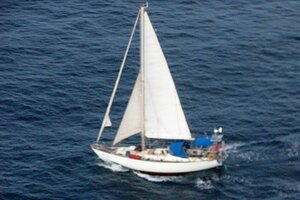Why Somali pirates are hijacking yachts in Seychelles
Missing British couple's yacht was found adrift near the Seychelles. Somali pirates are going further afield to dodge US, European naval patrols.

The yacht Lynn Rival, belonging to a British couple apparently taken captive by pirates off the east coast of Africa, is shown adrift in this image from Wednesday.
EU NAVFOR/AP
JOHANNESBURG, SOUTH AFRICA – With a mild tropical climate, magnificent palm-fringed beaches, Creole cuisine – and a distinct lack of naval patrols – it’s easy to see why the Seychelles Islands are a new base for Somali pirates.
Just this week, pirates from the port city of Haradhere, Somalia, picked up a Russian-owned tuna trawler with a crew of 25 and hijacked a British couple on their yacht – both of them just a few hundred miles off the Seychelles Island chain in the Indian Ocean.
According to Agence France-Presse news service, a European Union naval patrol plain spotted pirate skiffs aboard the Russian owned, Thai-flagged “Thai Union 3” fishing ship. A known Somali pirate leader said his men also captured Paul and Rachel Chandler, on their way from the Seychelles islands toward Tanzania. The Chandlers’ yacht was later discovered adrift, without its owners.
With the Indian Ocean monsoon season finished for 2009, the brief respite in the world’s biggest piracy problem is now officially over. Somali pirates have gone back to work. And despite beefed-up European and American naval task forces in the Indian Ocean (as well as those from India, China, and Japan), and now US military drones, pirates retain the upper hand, venturing as far away as the Seychelles to ply their trade.
To understand why Somali pirates would venture so far from home, let’s do the math. The Indian Ocean is about 26 million square miles, if you include all the waters from the African coast to Indonesia. Standard-issue pirate skiffs generally have a range of anywhere from 50 to 100 miles a day, but if a pirate skiff has taken control of a commercial ocean-going freighter that pirates can use as a mother ship, well, the world’s their oyster.
For an ambitious Somali pirate, the rewards of working off the Seychelles – where the usual ransom for releasing a commercial ship can be around $1.5 million to $2 million – are so attractive that the risks of plying the European and American-infested waters off the Somali coast just don’t seem worthwhile.
Holding eight ships
To date, various Somali pirate gangs – most of them based in the breakaway state of Puntland – now hold eight ships and 172 crew. Foreign naval patrols do a fair job of protecting ships within their area of patrol – as French and German naval ships managed this week to fend off a pirate attack on the French fishing vessel Cape Saint Vincent, taking seven suspected pirates into custody.
China says it will rescue its ship that was snagged by pirates Oct. 19.
US military drones – the MQ-9 Reapers stationed recently from a base on the Seychelles Islands – certainly add some military muscle to the naval patrols, but even US military experts say the only solution to Somali piracy is for Somalia to get an effective government.
Vice Adm. Robert Moeller, the US military deputy commander for Africa, admitted to the Associated Press that the military drones would not be devoted to piracy alone, but would also be patrolling Somalia itself for potential targets among what US and Somali government officials say is a growing presence of Al Qaeda fighters and terrorist cells.
Somali Prime Minister Omar Abdirashid Shamarke told an audience at the Royal Institute for International Affairs at Chatham House in London, “we cannot be certain of the precise size of their presence in our country, but Al Qaeda is here, they are training and planning in our land. Somalia is serving as an ideal place to them to regroup and redeploy.”
The solution, Mr. Shamarke told the Chatham House audience, is more than a matter of military strikes – it’s an issue of a strengthened Somali government. “An insurgency needs chaos, discontent, and poverty,” he said, adding, “We must take that away.”
_____
Pirates, Inc.: Inside the booming Somali business
